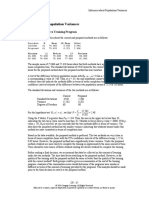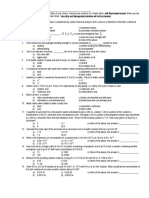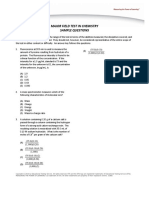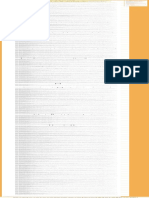Class Test 1: Section A (Multiple-Choice Questions)
Uploaded by
Kgaugelo TraciaClass Test 1: Section A (Multiple-Choice Questions)
Uploaded by
Kgaugelo TraciaCLASS TEST 1
SECTION A (MULTIPLE-CHOICE QUESTIONS)
For the following multiple-choice questions (1 – 10), choose the option that best answers the questions. Use the
attached sheet provided to mark the correct block clearly with an . Mark only one block per question. Make
sure your surname and student number are on the sheet.
1. Sucrose (C12H22O11) is reported in literature to have a solubility (in water at 25 ⁰C) of 70 g/(100 mL). When
an amount of 160 g is dissolved in 300 mL water, the resulting solution is…
(a). saturated
(b). supersaturated
(c). unsaturated
(d) dissociated
(e). desaturated
2. Choose the reaction that shows how a weak electrolyte will react.
(a). H 2SO 4 (aq) + H 2 O( )
HSO 4 (aq) + H 3O (aq)
(b). HCl(aq) + H 2 O( )
Cl (aq) + H 3O (aq)
(c). HNO3 (aq) + H 2 O( )
NO3 (aq) + + H3 O (aq)
(d) CH3CO 2 H(aq) + H 2 O( )
CH 3CO 2 (aq) + H 3O (aq)
(e). HClO 4 (aq) + H 2 O( )
ClO 4 (aq) + H3O (aq)
3. The amount of anhydrous copper(II) sulphate (CuSO4) that has to be dissolved in 250 mL of water to prepare a
solution with a concentration of 0.2500 mol.L1 is…
(a). 2 500 mg
(b). 9.9763 g
(c). 2.500 g
(d). 0.2500 g
(e). 9.9763 mg
4. What role does water play in the following reaction?
CH3COOH( ) + H 2O( )
CH3COO(aq) +
+ H3O(aq)
(a). acid
(b). electron pair donor
(c). oxidizing agent
(d). electron pair acceptor
(e). base
ACH150X Task 3 (Class Tests) Brief 2020 - 78 -
5. Choose the correct basicity constant expression for the following reaction.
C6 H11 NH 2 + H 2 O( )
C6 H11 NH 3 + H 3O
[C6 H11 NH 2 ][H 2 O]
(a). Kb
[C6 H11 NH3 ][H3O ]
[C6 H11 NH3 ][H 2 O]
(b). Kb
[C6 H11 NH 2 ][H3O ]
[H3O ][H3O ]
(c). Kb
[C6 H11 NH 2 ][C6 H11NH 3 ]
[C6 H11 NH3 ][C6 H11 NH 2 ]
(d). Kb
[H3O ][H 2O]
[C6 H11 NH3 ][H3O ]
(e). Kb
[C6 H11 NH 2 ]
6. Consider an indicator that ionized as shown below for which its Ka = 1.0 104.
HIn + H2O
H3O+ + In
yellow red
Which of the responses contains all the true statements and no others?
(1) The predominant colour in its acid range is yellow.
(2) In the middle of the pH range of its colour change a solution containing the indicator will probably be
orange.
(3) At pH = 7.00, a solution containing this indicator (and no other coloured species) will be red. (Hint:
Write the equilibrium constant expression for the indicator)
(4) At pH = 7.00, most of the indicator is in the un-ionized form.
(5) The pH at which the indicator changes colour is pH = 4.
(a). (1), (3), (5)
(b). (2), (4)
(c). (3), (4), (5)
(d). (1), (2), (3), (5)
(e). (2), (5)
ACH150X Task 3 (Class Tests) Brief 2020 - 79 -
7. Choose the best set of indicators to use for the following titration curve.
pH 7.4
Volume titrant added (mL)
(a). bromocresol purple, phenolphthalein
(b). phenol red, bromothymol blue
(c). thymol blue, methyl red
(d). phenolphthalein, thymolphthalein
(e). alizarin yellow, bromocresol green
8. Which of the following combinations cannot produce a buffer solution?
(a). HNO2 and NaNO2
(b). HCN and NaCN
(c). HClO4 and NaClO4
(d). NH3 and (NH4)2SO4
(e). NH3 and NH4Br
9. Consider a solution which is 0.1000 M in CH3COOH and 0.2000 M in CH3COONa. Which of the following
statements is true?
(a). If a small amount of NaOH is added, the pH decreases very slightly.
(b). If NaOH is added, the OH ions react with the CH3COO ions.
(c). If a small amount of HCl is added, the pH decreases very slightly.
(d). If HCl is added, the H+ ions react with CH3COOH ions.
(e). If more CH3COOH is added, the pH increases.
10. The key step to titration calculations is to relate:
(a). moles titrant to moles analyte.
(b). volume titrant to volume analyte.
(c). grams titrant to grams analyte.
(d). conductivity titrant to conductivity analyte.
(e). reduction titrant to oxidation analyte.
ACH150X Task 3 (Class Tests) Brief 2020 - 80 -
11. For the graphical equivalence point determination for a titration reaction, which of the following is/are
TRUE? (Hint: Consider the mathematical terminology used in the statements)
I The steepest slope of the titration curve is the equivalence point.
II The equivalence point occurs where the first derivative of the titration curve reaches its largest value.
III The equivalence point occurs where the second derivative of the titration curve equals zero.
(a). I only
(b). II and III
(c). II only
(d). III only
(e). I, II, and III
12. The following titration curve is the type expected for the titration of a ______ with a ______.
pH 7
Volume titrant added (mL)
(a). strong acid, strong base
(b). weak acid, strong base
(c). strong acid, weak base
(d). weak base, strong acid
(e). strong base, strong acid
[12 1 = 12]
ACH150X Task 3 (Class Tests) Brief 2020 - 81 -
ANALYTICAL CHEMISTRY 1 [ACH150X]
MULTIPLE-CHOICE ANSWER SHEET
TEST 1 (28 JUNE 2020)
NAME & SURNAME:
STUDENT NO:
SECTION A
MULTIPLE-CHOICE QUESTIONS
FOR EACH QUESTION MARK ONE BLOCK ONLY WITH AN
QUESTION OPTIONS
1. (a) (b) (c) (d) (e)
2. (a) (b) (c) (d) (e)
3. (a) (b) (c) (d) (e)
4. (a) (b) (c) (d) (e)
5. (a) (b) (c) (d) (e)
6. (a) (b) (c) (d) (e)
7. (a) (b) (c) (d) (e)
8. (a) (b) (c) (d) (e)
9. (a) (b) (c) (d) (e)
10. (a) (b) (c) (d) (e)
11. (a) (b) (c) (d) (e)
12. (a) (b) (c) (d) (e)
[12 1 = 12]
ACH150X Task 3 (Class Tests) Brief 2020 - 82 -
SECTION B
Answer the following questions in the spaces provided. Adhere to the number of decimal places specified for
calculations.
QUESTION 1 [CONCENTRATIONS/STOICHIOMETRY/EQUILIBRIUM]
(a). Describe the preparation for each of the following solution, showing all relevant calculations (answers
rounded to 4 decimal places): 250 mL of 2.000 M HNO3 from a concentrated solution that is 68% (m/v)
HNO3 and has a specific gravity of 1.41. (5)
(b). Calculate the pH of the following solution (answers rounded to 2 decimal places): 0.0500 M chloroacetic
acid (ClCH2CO2H), (Ka = 1.36 103) (3)
ACH150X Task 3 (Class Tests) Brief 2020 - 83 -
(c). Silver nitrate (12.6 g) reacts with calcium chloride (8.40 g). Answer the following questions.
(i). Write down the balanced chemical equation. (2)
(ii). Which is the limiting reagent? (answers to calculations rounded to 4 decimal places) (4)
(iii). Calculate the mass of AgCl formed when 12.6 g of AgNO3 reacts with 8.40 g of CaCl2. (answer
rounded to 2 decimal places) (2)
ACH150X Task 3 (Class Tests) Brief 2020 - 84 -
(d). Explain (using Le Châtelier’s principle) what would happen to the solubility of BaSO4 if it is dissolved in a
solution of Na2SO4. (3)
(e). Calculate the mass in grams of PbCl2 that will dissolve in 100 mL of 0.5 M KCl.
(Ksp of PbCl2 = 1.6 105) (7)
[26]
ACH150X Task 3 (Class Tests) Brief 2020 - 85 -
QUESTION 2: [PRINCIPLES OF NEUTRALIZATION TITRATIONS]
(a). The following data was collected from the titration of 50.00 mL of 0.0050 M NaOH with 0.0100 M HCl.
(i). Use the graph paper on the next page to plot the titration curve from the data. Label the axes
clearly. (7)
VHCl (mL) pH of solution
0.00 11.70
10.00 11.40
20.00 10.85
24.00 10.13
24.90 9.13
25.00 7.00
25.10 4.88
26.00 2.31
30.00 2.36
(ii). Select suitable indicators from the attached table, which could be used in the titration based on the
titration curve. (2)
(iii). Briefly explain your choice of indicators. (2)
[11]
TOTAL MARKS (SECTION B): 37
TOTAL MARKS: 49
G O O D L U C K ! !
ACH150X Task 3 (Class Tests) Brief 2020 - 86 -
Graph paper [Question 1(f)]
ACH150X Task 3 (Class Tests) Brief 2020 - 87 -
You might also like
- Practice Problem Set Mixed Chromatography QuestionsNo ratings yetPractice Problem Set Mixed Chromatography Questions14 pages
- ACH150X Course Study Notes (Class Test 2) 2020No ratings yetACH150X Course Study Notes (Class Test 2) 202011 pages
- MCQ Practice On (Chapter-3: Chemistry 1 Paper)100% (1)MCQ Practice On (Chapter-3: Chemistry 1 Paper)4 pages
- Instrumentation and Computer Aided Analysis Multiple Choice Question (Gurukpo)100% (2)Instrumentation and Computer Aided Analysis Multiple Choice Question (Gurukpo)7 pages
- Surface Chemistry MCQs - Questions - Paper 1No ratings yetSurface Chemistry MCQs - Questions - Paper 17 pages
- Analytical Chemistry & Numerical MCQ Test 5 - Makox MCQs80% (5)Analytical Chemistry & Numerical MCQ Test 5 - Makox MCQs5 pages
- CHEM 201 Self Quiz - 1 (Experimental Errors/Statistical Analysis)100% (1)CHEM 201 Self Quiz - 1 (Experimental Errors/Statistical Analysis)2 pages
- Group 7 - The Halogens (Multiple Choice) QP PDFNo ratings yetGroup 7 - The Halogens (Multiple Choice) QP PDF7 pages
- Analytical Chemistry & Numerical MCQ Test 3 - Makox MCQsNo ratings yetAnalytical Chemistry & Numerical MCQ Test 3 - Makox MCQs5 pages
- Questions On ISE Choose The Correct AnswerNo ratings yetQuestions On ISE Choose The Correct Answer3 pages
- Atomic Structure: Examples of Multiple Choice QuestionsNo ratings yetAtomic Structure: Examples of Multiple Choice Questions4 pages
- Sydney Boys 2019 Chemistry Trial PaperNo ratings yetSydney Boys 2019 Chemistry Trial Paper30 pages
- Sydney Boys 2019 Chemistry Trials & SolutionsNo ratings yetSydney Boys 2019 Chemistry Trials & Solutions46 pages
- Balancing More Complex Redox Reaction EquationsNo ratings yetBalancing More Complex Redox Reaction Equations4 pages
- Balancing More Complex Redox Reaction EquationsNo ratings yetBalancing More Complex Redox Reaction Equations4 pages
- ACH150X Course Study Notes (Principles of Neutralization Titrations) 2020No ratings yetACH150X Course Study Notes (Principles of Neutralization Titrations) 202013 pages
- ACH150X Complexation Reactions and Titrations 2020No ratings yetACH150X Complexation Reactions and Titrations 202040 pages
- ACH150X Course Study Notes (Precipitation Titrations) 2020No ratings yetACH150X Course Study Notes (Precipitation Titrations) 20208 pages
- Logit and Probit: Models With Discrete Dependent VariablesNo ratings yetLogit and Probit: Models With Discrete Dependent Variables30 pages
- MATLAB Homework 5: Exercise 5. 1 Load and Convert Data (2pts)No ratings yetMATLAB Homework 5: Exercise 5. 1 Load and Convert Data (2pts)2 pages
- Proposed Curriculum: Bugawas, Datu Odin Sinsuat, MaguindanaoNo ratings yetProposed Curriculum: Bugawas, Datu Odin Sinsuat, Maguindanao12 pages
- Haramaya University College of Computing and Informatics Department of StatisticsNo ratings yetHaramaya University College of Computing and Informatics Department of Statistics2 pages
- AMATH 460: Mathematical Methods For Quantitative Finance: 7.1 Lagrange's MethodNo ratings yetAMATH 460: Mathematical Methods For Quantitative Finance: 7.1 Lagrange's Method29 pages
- Introduction of Asymptotic Notation: Dr. Munesh SinghNo ratings yetIntroduction of Asymptotic Notation: Dr. Munesh Singh14 pages
- A Tutorial On Optimal Control Theory: Suresh P. SethiNo ratings yetA Tutorial On Optimal Control Theory: Suresh P. Sethi14 pages
- Fixed Point Theory and Applications: January 2011No ratings yetFixed Point Theory and Applications: January 201115 pages
- Hypothesis Test For Two Independent ProportionsNo ratings yetHypothesis Test For Two Independent Proportions23 pages
- 3.1 Time-Domain Analysis of Control Systems: Unit-IiiNo ratings yet3.1 Time-Domain Analysis of Control Systems: Unit-Iii23 pages
- Chapter 13 PARTIAL DERIVATIVES Pertemuan 1 Dan 2 6 April 2020 PDFNo ratings yetChapter 13 PARTIAL DERIVATIVES Pertemuan 1 Dan 2 6 April 2020 PDF107 pages
- Absolute Convergence and Conditional ConvergenceNo ratings yetAbsolute Convergence and Conditional Convergence7 pages
- Practice Problem Set Mixed Chromatography QuestionsPractice Problem Set Mixed Chromatography Questions
- Instrumentation and Computer Aided Analysis Multiple Choice Question (Gurukpo)Instrumentation and Computer Aided Analysis Multiple Choice Question (Gurukpo)
- Analytical Chemistry & Numerical MCQ Test 5 - Makox MCQsAnalytical Chemistry & Numerical MCQ Test 5 - Makox MCQs
- CHEM 201 Self Quiz - 1 (Experimental Errors/Statistical Analysis)CHEM 201 Self Quiz - 1 (Experimental Errors/Statistical Analysis)
- Analytical Chemistry & Numerical MCQ Test 3 - Makox MCQsAnalytical Chemistry & Numerical MCQ Test 3 - Makox MCQs
- Atomic Structure: Examples of Multiple Choice QuestionsAtomic Structure: Examples of Multiple Choice Questions
- ACH150X Course Study Notes (Principles of Neutralization Titrations) 2020ACH150X Course Study Notes (Principles of Neutralization Titrations) 2020
- ACH150X Complexation Reactions and Titrations 2020ACH150X Complexation Reactions and Titrations 2020
- ACH150X Course Study Notes (Precipitation Titrations) 2020ACH150X Course Study Notes (Precipitation Titrations) 2020
- Logit and Probit: Models With Discrete Dependent VariablesLogit and Probit: Models With Discrete Dependent Variables
- MATLAB Homework 5: Exercise 5. 1 Load and Convert Data (2pts)MATLAB Homework 5: Exercise 5. 1 Load and Convert Data (2pts)
- Proposed Curriculum: Bugawas, Datu Odin Sinsuat, MaguindanaoProposed Curriculum: Bugawas, Datu Odin Sinsuat, Maguindanao
- Haramaya University College of Computing and Informatics Department of StatisticsHaramaya University College of Computing and Informatics Department of Statistics
- AMATH 460: Mathematical Methods For Quantitative Finance: 7.1 Lagrange's MethodAMATH 460: Mathematical Methods For Quantitative Finance: 7.1 Lagrange's Method
- Introduction of Asymptotic Notation: Dr. Munesh SinghIntroduction of Asymptotic Notation: Dr. Munesh Singh
- A Tutorial On Optimal Control Theory: Suresh P. SethiA Tutorial On Optimal Control Theory: Suresh P. Sethi
- 3.1 Time-Domain Analysis of Control Systems: Unit-Iii3.1 Time-Domain Analysis of Control Systems: Unit-Iii
- Chapter 13 PARTIAL DERIVATIVES Pertemuan 1 Dan 2 6 April 2020 PDFChapter 13 PARTIAL DERIVATIVES Pertemuan 1 Dan 2 6 April 2020 PDF
































































































